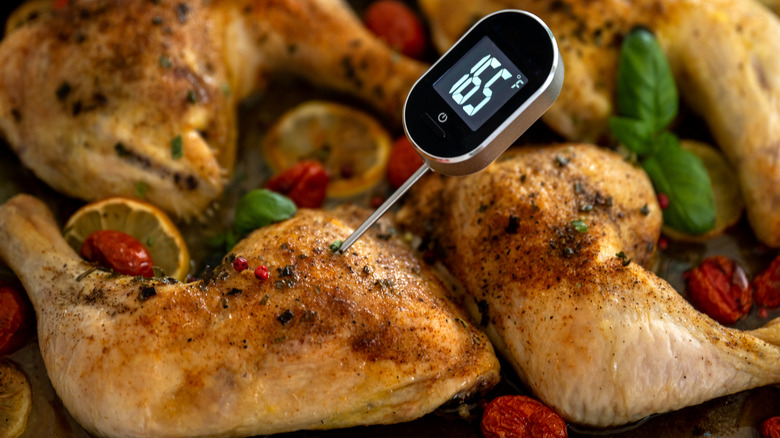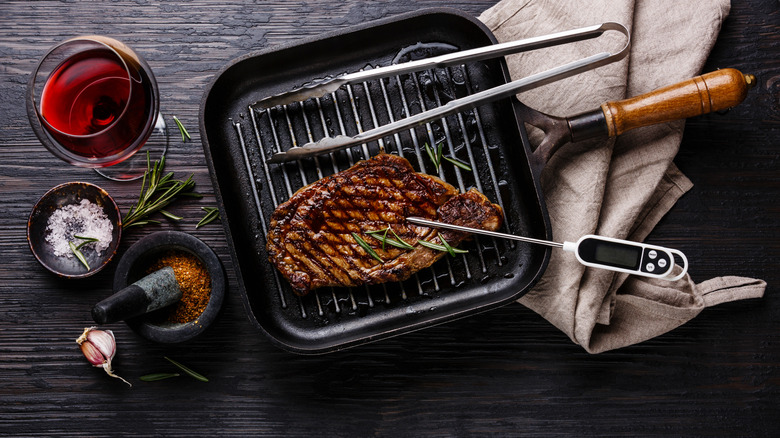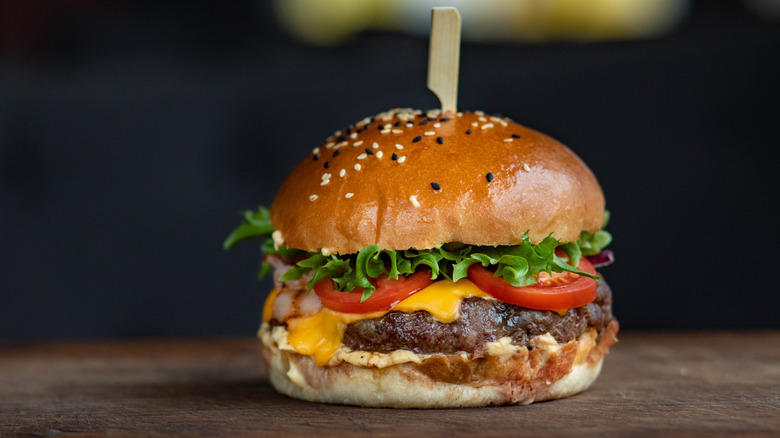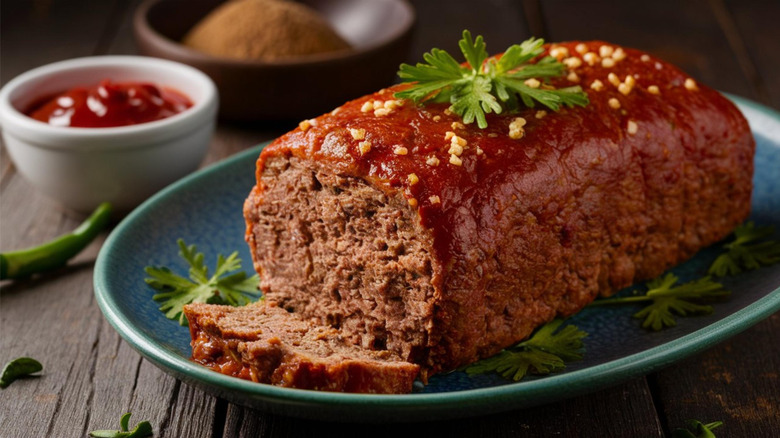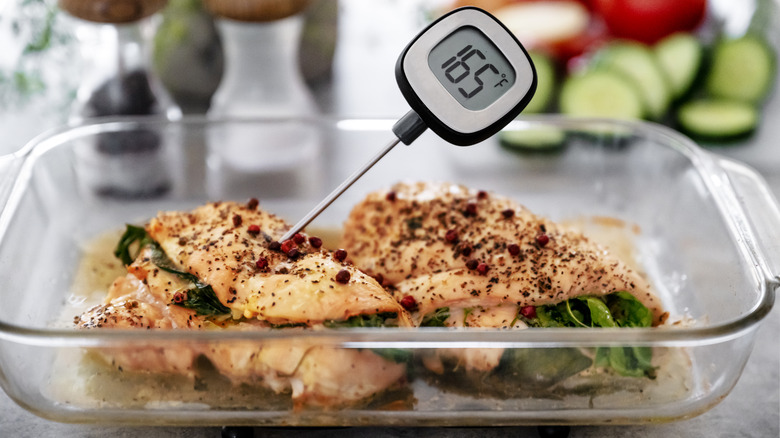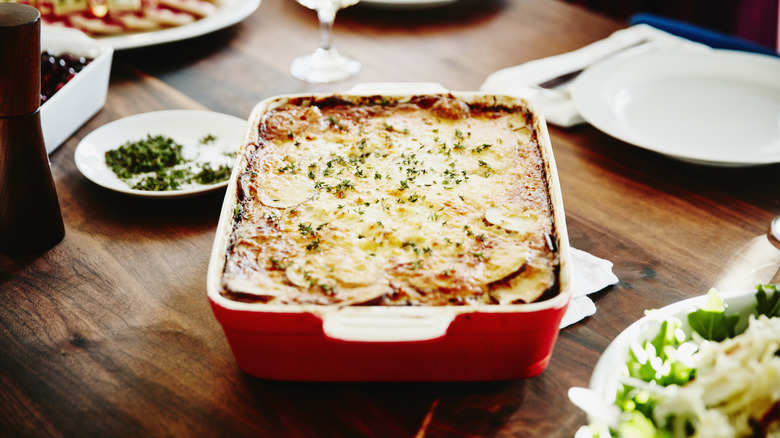How To Properly Use A Meat Thermometer
Cooking anything perfectly, but especially meat, can often seem like it requires some alchemical blend of art, science, and magic. There are ways that — with some experience — you can start to get a sixth sense for, say, when steaks are done. But unless you're spending your days cooking piece after piece of meat (like you would in a restaurant), it can be hard to develop. There are methods, like Gordon Ramsay's poke test for steak doneness, that can make the guesswork a little easier. Still, the only truly foolproof way of telling the doneness of your meat is by using a thermometer. With one, the guesswork goes away entirely, and you can know exactly when to pull your meat from the stove or oven for the perfect cook — plus, it'll help you avoid potentially getting sick! There's a reason why they're so widely used in the food industry.
There are several types of thermometers you can use, but the two most common are the leave-in, oven-proof probes, which are placed into the meat prior to cooking and remain inserted throughout the process, and instant-read thermometers, which you can insert into the meat to give an accurate read right then and there. These are the best option for smaller cuts of meat, like chicken thighs or steaks. Whichever type you choose, though, knowing the right technique for different types of meat is crucial for achieving the most accurate temperature readings.
How to use a temperature probe on red meat
Red meat is a particular challenge when it comes to avoiding overcooking, whether it comes in the form of steaks, big, succulent roasting joints of beef or lamb, or delicious, crispy, dry-brined pork chops. Temperature matters, and there can be painfully small margins between a perfectly tender medium-rare and a sad, gray, overcooked piece of meat. Luckily, the process for checking the temperature of red meat is simple and doesn't change much depending on what you happen to be cooking. In the case of an instant-read temperature probe, you're going to want to insert the thermometer into the center, in the thickest part of the meat. Be sure to keep the tip of the probe away from any bones, fat, or gristle, as these will likely be at a different temperature than the meat itself.
For beef, the temperature to aim for will vary depending on the doneness you'd like to achieve — a rare steak, for example, will sit at around 120 to 130 degrees Fahrenheit, whereas a medium cook will require an internal temperature of 135 to 145 degrees. Other red meats, like lamb and pork, will have different temperature requirements based on the minimum safe temperature the meat needs to reach before it can be eaten (160 degrees Fahrenheit for pork, for example). Just remember to check these minimum temps before you start cooking, and you'll be off to the races!
Burgers have their own technique
Though burgers are (most of the time, anyway) made of red meat, they have different temperature requirements and a slightly different technique when it comes to measuring that temperature. To get an accurate read on the temperature of your burgers, insert the thermometer probe into the center — but instead of doing it from the top, go in from the side of the patty. Most digital-read thermometers can give an accurate reading after only being inserted half an inch, but it's best to be as certain as possible.
When it comes to temperature, though chefs like Bobby Flay often prefer their beef burgers at a medium (or even medium-rare) doneness, you should only aim for that result at home if you're grinding your own meat. Otherwise, there is a higher risk of illness from potential bacteria exposure that isn't cooked off. To ensure a proper cook on store-bought ground beef, aim for an internal temperature of 160 degrees Fahrenheit.
What about other ground meats like meatloaf?
When it comes to other dishes that use ground meats, like a classic all-American meatloaf or meatballs, the same minimum safe internal temperature of 160 degrees Fahrenheit still applies. Be sure to insert the probe into the very center or the thickest part of the meat.
Using a thermometer is especially important in these cases, as it can often be hard to tell the doneness of something like meatloaf just by looking at it. Ingredients like onions, which are commonly used in meatballs and meatloaf, have a naturally high nitrate content that can cause the meat to stay pink even after it has been fully cooked. This can mislead chefs who don't have a thermometer on hand.
Using a thermometer is crucial when cooking poultry
For many people, cooking poultry (like chicken or turkey) correctly is a source of great anxiety. While there's no need to be anxious about getting sick from cooking poultry — as long as you do it properly and remember to wash your hands, the risk is minimal — it's still essential to make sure that poultry is fully cooked before eating. The USDA provides simple guidelines: "All poultry should reach a safe minimum internal temperature of 165 [degrees Fahrenheit] ... as measured with a food thermometer."
If you're cooking a whole bird, place the tip of your thermometer into the thigh meat, close to the bird's breast. As with red meat, ensure your thermometer isn't touching any bone, as that can affect the accuracy of the reading. Once the meat hits the golden temperature of 165 degrees Fahrenheit, pull it from the heat and leave it to rest — just like a steak. Resting allows all those lovely juices to redistribute throughout the meat, giving you the most delicious, tender, and juicy bite possible!
How to read the temperature of casseroles and egg dishes
Whole pieces of meat aren't the only things that benefit from temperature checks. Whether you're making hearty chicken or a comforting steak and ale casserole, a little scientific precision can go a long way.
As always, just make sure to insert the thermometer at least half an inch deep into the very center of the casserole to read the temperature accurately. You can base the minimum temperature you need to reach on the ingredients in your casserole, as different meats require different cooking temperatures.

